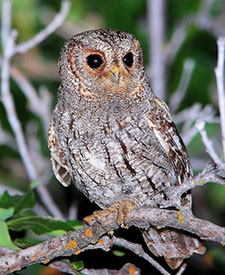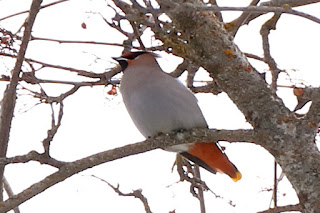February 15-18th is the time to count your backyard and feeder birds. You can post your results for all the world to see at the
Great Backyard Bird Count web site, sponsored by the
Cornell Lab Of Ornithology This is a great way to begin your interest in birding. The best way to become familiar with the local birds is to learn to identify the ones that visit you!
Common winter visitors to backyard feeders in Northeast Washington include the House Finch, American Goldfinch, Oregon Dark-eyed Junco, California Quail, and Eurasian Collared Dove. Other common visitors to yards include the American Robin, European Starling and, if you're lucky, a Varied Thrush or the Bohemian Waxwing (or it's close cousin the Cedar Waxwing).
The things that attract birds to your yard are good cover, a regular supply of favorite foods that help them get through the winter months, and little to no disturbance. Birds are stressed during winter to keep warm and avoid predators. Being able to quickly move from cover to food, and quickly back again, is essential for their survival. So when they do pay a visit have the table set and enjoy the live entertainment.
Favorite foods include:#1 sunflower seeds, lots of sunflower seeds. You can buy the hulled naked seeds or whole seeds. I think the birds like the whole seeds best because it is natural for them to break open seeds in the wild and pluck out the seeds with their incredibly active tongues. The naturally high oil content of sunflower seeds provide essential calories for the birds to burn during the cold days of winter. A large oil-rich sunflower seed is like gold in the cold. Birds that love these seeds include the House Finch, Black capped chickadee, California Quail, Mourning and Eurasian Collared Doves. These birds will also eat the wild bird seed mixes that you often see in the stores.
Another good source of calories are suet blocks. These mixes of seeds and berries are held together by fatty suet and hung in cages suspended form hooks on railings, posts, or roof overhangs. Nuthatches, woodpeckers and even the occasional Varied Thrush, can bee seen frequenting these dense blocks of nutrition.
Lastly, black nijer thistle seeds are the
best for American Goldfinches, Oregon Dark-eyed Juncos and Common Redpolls. These are held in either long feeding cylinders or nylon netted socks. Nijer seeds are tiny, but packed with oil for a dense source of calories for these active birds. The goldfinches and redpolls like to feed on the cylinder perches or climb crazily on the netted socks. It's not uncommon to see 10-12 of these birds crawling all over the nijer seed feeders. To attract juncos, just spread a handful along your porch railing and watch them go nuts with their newly found goldmine.
So take a look out the window this weekend, and join the world wide
Great Backyard Bird Count this weekend.
- Hawkeye
American Goldfinches on nijer thistle seed sock
The Black-capped Chickadee is noisy and curious
The stunning Bohemian Waxwing (note the rust red under the tail. The Cedar Waxwing is yellow in this region of the bird)
The California Quail is fun to watch and listen to as the covey calls to each other to stay close.
The Dark-eyed junco (Oregon) is a welcome visitor to porch railing scattered with nijer seeds.
This is the Eurasian Collared Dove (note the black collar on the back of the neck). Mourning Doves are a little smaller and have black spots along their backs.
A female House Finch
A male House Finch














